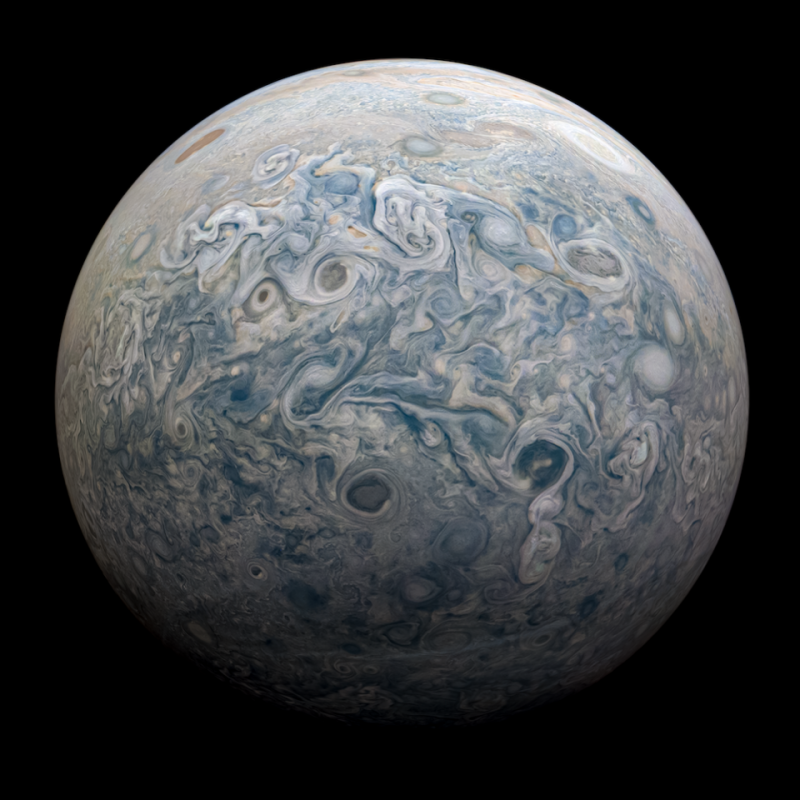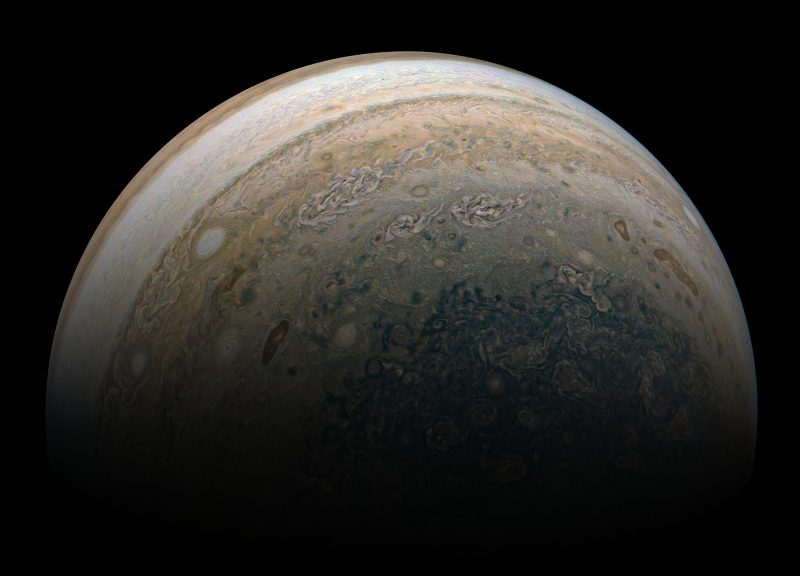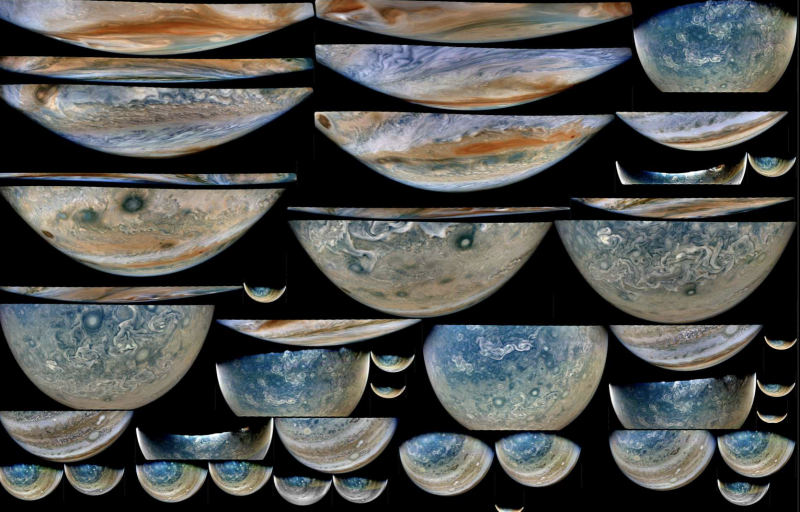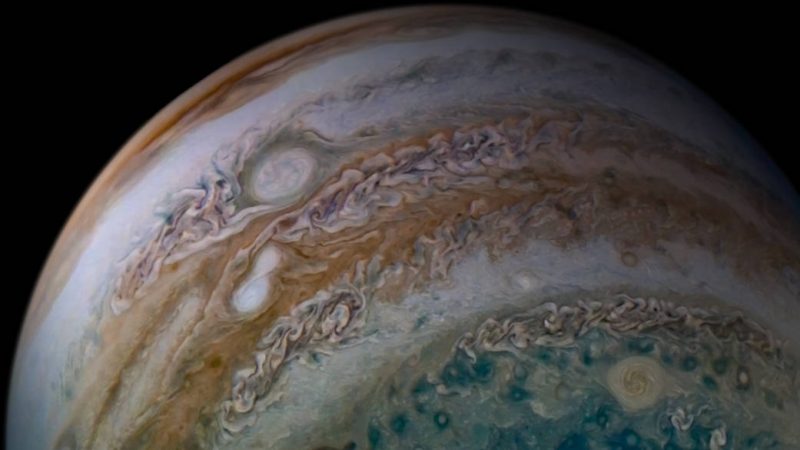

Jupiter at mid-northern latitudes as seen by Juno during Perijove 25. The small, round, swirly spots are storms in Jupiter’s atmosphere. Image via NASA/ JPL-Caltech/ SwRI/ MSSS/ Kevin M. Gill.
The Juno mission to Jupiter has been orbiting the giant planet since 2016, and NASA has made the raw images from Juno’s camera available to the public for processing. Click here if you want to help. Juno has a 53-day orbit around Jupiter, and close passes of the planet are called perijoves, from the Greek word peri meaning near. Images are now coming in from Juno’s most recent close sweep past the planet, Perijove 25, on February 17, 2020. We’ve also included some images on this page from the next-to-last sweep past Jupiter (Perijove 24) on December 26, 2019.

Jupiter as seen from the south, also from Perijove 25. Image via NASA/ JPL-Caltech/ SwRI/ MSSS/ Kevin M. Gill.
Brian Swift processed the video below, using imagery from the JunoCam instrument during Perijove 25.
The best place to see the latest processed images from Juno is probably Twitter. Follow the three people below, who are active in image processing.
Fisheye view of Jupiter at mid-northern latitudes, @NASAJuno Perijove 25https://t.co/6fseaG9kI9 pic.twitter.com/JJh3gT4q5G
— Kevin M. Gill (@kevinmgill) February 24, 2020
— Seán Doran (@_TheSeaning) February 24, 2020
A mosaic from @NASAJuno images PJ25_25 and PJ25_27 obtained on Feb 17, 2020. Approx true color/contrast and enhanced versions. The oval left of center is known as NN-WS-4. It is about 7000 km long in the east-west direction and is at planetographic latitude ~42 degrees north. pic.twitter.com/EDlNngkwTe
— Björn Jónsson (@bjorn_jons) February 24, 2020

Here’s a mosaic of images of Jupiter, processed and assembled by Brian Swift from Perijove 24. He labeled this as a “collage [with] exaggerated contrast/color.” Image via NASA/ JPL-Caltech/ SwRI/ MSSS/ Brian Swift.
And here’s a cool image to end on, processed by citizen scientist Tanya Oleksuik and released by NASA on March 2, 2020. It’s from the second-to-last close sweep past Jupiter by Juno, in December 2019 (Perijove 24). Tanya created this color-enhanced image using data from the JunoCam camera.

See the 2 white ovals merging, within the orange-colored band? NASA’s Juno spacecraft caught these 2 storms in the act of merging on December 26, 2019, a few days after a close flyby of the planet (Perijove 24). The 2 merging white ovals are anticyclones; they rotate counter-clockwise. The larger of the ovals has been tracked for many years, as it grew in size through mergers with other anticyclonic white ovals on Jupiter. Read more about this image. Image via NASA/ JPL-Caltech/ SwRI/ MSSS/ Tanya Oleksuik.
Bottom line: Newly processed images from the days around the Juno spacecraft’s most recent low pass over the planet – called a “perijove” – on December 17, 2019.
from EarthSky https://ift.tt/2wvAOvo


Jupiter at mid-northern latitudes as seen by Juno during Perijove 25. The small, round, swirly spots are storms in Jupiter’s atmosphere. Image via NASA/ JPL-Caltech/ SwRI/ MSSS/ Kevin M. Gill.
The Juno mission to Jupiter has been orbiting the giant planet since 2016, and NASA has made the raw images from Juno’s camera available to the public for processing. Click here if you want to help. Juno has a 53-day orbit around Jupiter, and close passes of the planet are called perijoves, from the Greek word peri meaning near. Images are now coming in from Juno’s most recent close sweep past the planet, Perijove 25, on February 17, 2020. We’ve also included some images on this page from the next-to-last sweep past Jupiter (Perijove 24) on December 26, 2019.

Jupiter as seen from the south, also from Perijove 25. Image via NASA/ JPL-Caltech/ SwRI/ MSSS/ Kevin M. Gill.
Brian Swift processed the video below, using imagery from the JunoCam instrument during Perijove 25.
The best place to see the latest processed images from Juno is probably Twitter. Follow the three people below, who are active in image processing.
Fisheye view of Jupiter at mid-northern latitudes, @NASAJuno Perijove 25https://t.co/6fseaG9kI9 pic.twitter.com/JJh3gT4q5G
— Kevin M. Gill (@kevinmgill) February 24, 2020
— Seán Doran (@_TheSeaning) February 24, 2020
A mosaic from @NASAJuno images PJ25_25 and PJ25_27 obtained on Feb 17, 2020. Approx true color/contrast and enhanced versions. The oval left of center is known as NN-WS-4. It is about 7000 km long in the east-west direction and is at planetographic latitude ~42 degrees north. pic.twitter.com/EDlNngkwTe
— Björn Jónsson (@bjorn_jons) February 24, 2020

Here’s a mosaic of images of Jupiter, processed and assembled by Brian Swift from Perijove 24. He labeled this as a “collage [with] exaggerated contrast/color.” Image via NASA/ JPL-Caltech/ SwRI/ MSSS/ Brian Swift.
And here’s a cool image to end on, processed by citizen scientist Tanya Oleksuik and released by NASA on March 2, 2020. It’s from the second-to-last close sweep past Jupiter by Juno, in December 2019 (Perijove 24). Tanya created this color-enhanced image using data from the JunoCam camera.

See the 2 white ovals merging, within the orange-colored band? NASA’s Juno spacecraft caught these 2 storms in the act of merging on December 26, 2019, a few days after a close flyby of the planet (Perijove 24). The 2 merging white ovals are anticyclones; they rotate counter-clockwise. The larger of the ovals has been tracked for many years, as it grew in size through mergers with other anticyclonic white ovals on Jupiter. Read more about this image. Image via NASA/ JPL-Caltech/ SwRI/ MSSS/ Tanya Oleksuik.
Bottom line: Newly processed images from the days around the Juno spacecraft’s most recent low pass over the planet – called a “perijove” – on December 17, 2019.
from EarthSky https://ift.tt/2wvAOvo

Aucun commentaire:
Enregistrer un commentaire